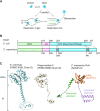The Caulobacter crescentus DciA promotes chromosome replication through topological loading of the DnaB replicative helicase at replication forks
- PMID: 36484102
- PMCID: PMC9825169
- DOI: 10.1093/nar/gkac1146
The Caulobacter crescentus DciA promotes chromosome replication through topological loading of the DnaB replicative helicase at replication forks
Abstract
The replicative DNA helicase translocates on single-stranded DNA to drive replication forks during chromosome replication. In most bacteria the ubiquitous replicative helicase, DnaB, co-evolved with the accessory subunit DciA, but how they function remains incompletely understood. Here, using the model bacterium Caulobacter crescentus, we demonstrate that DciA plays a prominent role in DNA replication fork maintenance. Cell cycle analyses using a synchronized Caulobacter cell population showed that cells devoid of DciA exhibit a severe delay in fork progression. Biochemical characterization revealed that the DnaB helicase in its default state forms a hexamer that inhibits self-loading onto single-stranded DNA. We found that upon binding to DciA, the DnaB hexamer undergoes conformational changes required for encircling single-stranded DNA, thereby establishing the replication fork. Further investigation of the functional structure of DciA revealed that the C-terminus of DciA includes conserved leucine residues responsible for DnaB binding and is essential for DciA in vivo functions. We propose that DciA stimulates loading of DnaB onto single strands through topological isomerization of the DnaB structure, thereby ensuring fork progression. Given that the DnaB-DciA modules are widespread among eubacterial species, our findings suggest that a common mechanism underlies chromosome replication.
© The Author(s) 2022. Published by Oxford University Press on behalf of Nucleic Acids Research.
Figures







Similar articles
-
DciA, the Bacterial Replicative Helicase Loader, Promotes LLPS in the Presence of ssDNA.J Mol Biol. 2025 Jan 15;437(2):168873. doi: 10.1016/j.jmb.2024.168873. Epub 2024 Nov 26. J Mol Biol. 2025. PMID: 39603490
-
Overexpression of the Replicative Helicase in Escherichia coli Inhibits Replication Initiation and Replication Fork Reloading.J Mol Biol. 2016 Mar 27;428(6):1068-1079. doi: 10.1016/j.jmb.2016.01.018. Epub 2016 Jan 23. J Mol Biol. 2016. PMID: 26812209 Free PMC article.
-
Biochemical characterization of Escherichia coli DnaC variants that alter DnaB helicase loading onto DNA.J Biol Chem. 2024 May;300(5):107275. doi: 10.1016/j.jbc.2024.107275. Epub 2024 Apr 6. J Biol Chem. 2024. PMID: 38588814 Free PMC article.
-
Structural Insight Into the Function of DnaB Helicase in Bacterial DNA Replication.Proteins. 2025 Feb;93(2):420-429. doi: 10.1002/prot.26746. Epub 2024 Sep 4. Proteins. 2025. PMID: 39230358 Review.
-
Replication Initiation in Bacteria.Enzymes. 2016;39:1-30. doi: 10.1016/bs.enz.2016.03.001. Epub 2016 Apr 20. Enzymes. 2016. PMID: 27241926 Free PMC article. Review.
Cited by
-
DnaB and DciA: mechanisms of helicase loading and translocation on ssDNA.Nucleic Acids Res. 2025 Jun 20;53(12):gkaf521. doi: 10.1093/nar/gkaf521. Nucleic Acids Res. 2025. PMID: 40598899 Free PMC article.
-
Diverse Mechanisms of Helicase Loading during DNA Replication Initiation in Bacteria.J Bacteriol. 2023 Apr 25;205(4):e0048722. doi: 10.1128/jb.00487-22. Epub 2023 Mar 6. J Bacteriol. 2023. PMID: 36877032 Free PMC article. Review.
-
Inhibition of Replication Fork Formation and Progression: Targeting the Replication Initiation and Primosomal Proteins.Int J Mol Sci. 2023 May 15;24(10):8802. doi: 10.3390/ijms24108802. Int J Mol Sci. 2023. PMID: 37240152 Free PMC article. Review.
-
Frequent nonhomologous replacement of replicative helicase loaders by viruses in Vibrionaceae.Proc Natl Acad Sci U S A. 2024 May 7;121(19):e2317954121. doi: 10.1073/pnas.2317954121. Epub 2024 Apr 29. Proc Natl Acad Sci U S A. 2024. PMID: 38683976 Free PMC article.
-
DciA secures bidirectional replication initiation in Vibrio cholerae.Nucleic Acids Res. 2024 Nov 11;52(20):12324-12333. doi: 10.1093/nar/gkae795. Nucleic Acids Res. 2024. PMID: 39291731 Free PMC article.
References
-
- Katayama T., Ozaki S., Keyamura K., Fujimitsu K.. Regulation of the replication cycle: conserved and diverse regulatory systems for DnaA and oriC. Nat. Rev. Microbiol. 2010; 8:163–170. - PubMed

